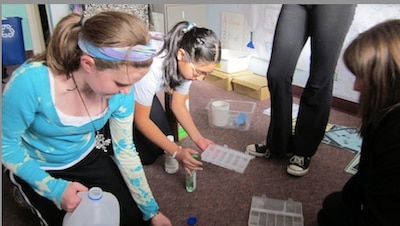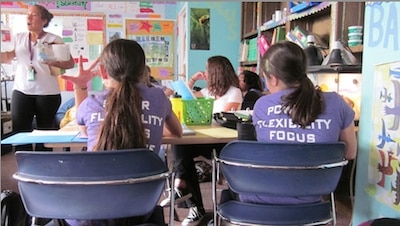Walk into GALS school in Denver, and a few things catch your eye:

Everyone’s wearing athletic shoes. Students in some classrooms are lounging on the floor or sitting on bouncy balls. There are plants in the bathroom urinals.
But none of these are the most unusual aspect of this charter school.
What is? No boys.
However, there are plenty of sweaty, middle school girls power-skipping through hallways and raising their hands so exuberantly in class you worry their shoulders will dislocate.
Colorado’s first all-girls’ charter school
GALS, which stands for Girls Athletic Leadership School, is making waves as the first girls-only charter school in Colorado.
The school, with a mission that focuses on the physical and mental health of students and staff, is now in its third year. Next year, it will move into the former Del Pueblo elementary building, at 750 Galapago St., from its tight quarters in an upper floor of a Calvary Temple building at 200 S. University Blvd.
Some challenges regarding resources, space and programming have been overcome and some remain. But Denver Public Schools’ staff recently recommended that GALS get three more years on its charter contract, with the option of a fourth if certain conditions are met. The school board approved the contract extension Thursday.
“GALS is an example of a school that largely flies under the radar in Denver’s education community,” DPS board President Mary Seawell said. “It has been under-appreciated from the time it first applied for a charter to even now, when it has two years of promising performance under its belt.
“I think now that it has a long-term facility, it will be able to grow and strengthen even more.”
Liz Wolfson, GALS co-founder and head of school, believes single-gender academic programs at the secondary level are essential to cultivating female leaders who are self-confident, critical thinkers. Studies have also shown that athleticism is directly tied to leadership skills in girls and women. For instance, a 2002 survey by Oppenheimer Funds found that 82 percent of female business executives had played organized sports after elementary school.
The GALS school’s brochure states that GALS “engages health and wellness as a key contributing factor in optimizing academic achievement and self-development.”
In short, Wolfson said, healthy bodies fuel healthy minds.
More than special programs needed
Wolfson does not believe it’s enough to offer specialized summer camps or after-school programs for girls as a way to promote leadership skills.

“It’s the birthright of girls to be empowered from day one in the place they spend most of their time,” she said.
Wolfson’s goal is to create a safe and supportive space to help young women figure out who they are so they can discover their passions.
For GALS student Imani Porter, 11, there is another major benefit to the GALS model – no boys to distract you.
“Here you can get your work done better,” Porter said. “At my old school, guys were always disrespecting girls and calling them names.”
A peak in the classroom
As with most novel school programs, visitors are routine and welcome. Show up at the front office and you are provided with a map. Pop in a classroom and a student clad in black sweats or yoga pants greets you, offering a description of the current activity.
The instructional model is hands-on and group-oriented, often with real-world applications.
In an eighth-grade social studies class, while studying World War II, the students pondered recent cases involving the delicate balance between protecting national security and individual rights. In a science classroom, eighth-graders ran Hot Wheels toy cars down various ramps of different heights to record distance based on conditions and materials used.
“Research shows girls learn best when (lessons are) tied directly to relevance,” Wolfson said, in between juggling a report of a kid sick in a bathroom and various urgent-sounding messages from the office via two-way radio.
How movement is incorporated
In addition, physical movement is an integral part of every school day.
Four days each week, every student starts her day with 45 minutes of movement, usually running or circuit training, all designed to get heart rates up for at least 20 minutes. Teachers also provide regular “brain breaks” in class, which may require girls to stand up and do “right brain, left brain cross-over motions.” If a girl is having trouble focusing, she might be asked to run up and down the hallways.
Classroom furniture such as “standing desks,” chair frames for exercise balls and rocking chairs also facilitate constant movement during academic lessons.
That explains the school’s unusual dress code. Students and staff must wear black bottoms – shorts, skorts or yoga pants. On top, they can wear a GALS shirt or a white shirt and they can also wear a gray or black sweater or sweatshirt. Everyone wears athletic shoes. Any exposed midriffs or cleavage gets you sent to pick out more appropriate clothing from a bin at the school.
“They have to be able to run a mile or do yoga at any given time,” Wolfson said.
At first, the girls complained about the dress code but at a recent student council meeting, student feedback was positive. Students said it influenced their ability to make friends without judging where those students came from or how much money they had.
GALS demographics
Sixty-five percent of the school’s 180 students are students of color and 54 percent qualify for federal lunch aid, an indicator of poverty.
Several staff members and students said they value the diversity at GALS. At the same time, students have something important in common – their gender. At a recent meeting with class representatives, students brought questions and concerns about bathroom sanitation and the need to support girls who were just beginning their menstrual cycles.
“Two hundred girls here are getting their period and we’re allowed to talk about it,” Wolfson said.
It was the single-gender education model and the student diversity that attracted Teach For America alumna Liz Reetz, 22, who teaches sixth-grade social studies.
“I was really excited to teach in a school that wasn’t so homogenous,” she said. “It’s a really good place to work in terms of teacher quality of life. I get to work out with the girls. The environment isn’t really rigid or stressful.”
Teaching is still challenging work, she added, regardless of the school’s seemingly laid-back atmosphere.
“I love working here,” Reetz said. “The students are really engaged. The school culture helps build that. They feel comfortable and safe to engage.”
Goals for GALS
Wolfson has lofty goals for GALS – that it both expand to include high school and become the first of many such GALS schools across the country. She envisions future U.S. senators and corporate CEOs proudly proclaiming themselves GALS alumni.
The school, one of two single-gender charters now operating in DPS, will not start adding high school grades for at least another year. But the school’s board of directors is busy working out expansion details. The goal is to have 600 students, half in middle school and half in high school.
Wolfson crafted the vision for GALS but says it would not exist without the enthusiasm and energy of Nina Safane, the school’s director of health and wellness. Safane was still in college when Wolfson hired her as an intern. They shared a dream about the need to better educate girls.
“We really hit it off,” Wolfson says, noting that their “intergenerational relationship” fueled creativity.
“We are making sure girls have access to every opportunity so they have a choice to be a mom or a high-powered executive or both at a certain period of time, she said. “That is the definition of having it all.”
Wolfson is an example of those different roles. She’s 45 and has two daughters, ages 6 and 22 months. Before entering education, she lived in Israel and worked in high tech as a consultant who is credited with bringing the United Way to the Middle East. Former Israeli Prime Minister Ehud Barak was her first client.
“I am a start-up person by nature,” Wolfson said.
When she returned to the U.S., she said she couldn’t find people she wanted to work for. At the same time, she connected with a couple of childhood friends who had become educators. Wolfson landed work creating a comprehensive development plan for the American Montessori Society. The idea of starting a school began to take root.
Challenges remain
GALS staff acknowledge various course corrections along the way. For instance, the school eliminated a range of elective classes this year to focus on the school’s core mission.
“We made this conscious decision we could do a lot of things mediocre or do a few things really well,” said seventh-grade social studies teacher Jennifer Derosby.
Money has been the main issue. The school has had to work hard to foster community relationships and build additional support financially and otherwise. But there still isn’t enough money to pay for all the field trips teachers want students to take or to hire more teachers.
“The first school is always the hardest,” Wolfson said. “You come up against huge obstacles, mostly resource-based.”
While GALS’ focus on girls and physical movement is innovative, Wolfson said the desire for innovation in education is “both a blessing and burden.”
“While I believe districts and states want it, they still want it all figured it out beforehand,” she said. “The word ‘innovation’ is a catch-22 in today’s world of education. Is it actually innovation, or just innovation because you’re giving folks a bit of wiggle room to do something?”
Ratings for GALS dip in some areas
Meeting DPS’ performance expectations has been challenging too.

The first year, the school’s test scores and other indicators “blew them out of the water,” Wolfson said of district leaders. But it proved difficult to maintain that academic growth.
While district staff recommended a three-year contract extension for GALS, a citizens group charged with reviewing the same data recommended the school only get two years.
Members of the School Improvement Accountability Council wrote: “GALS fell short of meeting its target of a 40% (English language learner) population. While GALS is a district program and not boundary bound, for many families, location is still a factor in choosing a school. The move to Del Pueblo next year may assist in attracting more ELL students.”
At a recent DPS school board meeting, the district’s chief of innovation and reform described the staff recommendation for a longer contract term for GALS.
“They’re performing better than the DPS average but not as competitively as similar school clusters,” Alyssa Whitehead-Bust said. “Their performance in a two-year history declined one year to the next. That’s something we want to continue to monitor closely, but there is a strong culture and educational programs.
“We are looking forward to being able to offer more supports to teachers.”
School hoping for more English language learners
DPS board member Andrea Merida said she is most concerned about the small number of English language learners at the school, which is between 6 and 8 percent.
“GALS can avoid linguistic segregation and be a legitimate choice for all female DPS students and show a commitment to diversity and inclusion by providing the right services for English learners,” Merida said. “I was happy to vote for GALS in my first board meeting, and if they can show a solid plan for properly supporting ELs, I will be happy to support their charter renewal for four years.”
Despite uneven performance, students and families are showing interest in GALS.
Wolfson said the number of students signing up to shadow GALS students in preparation for choosing a middle school doubled over last year.
“We are a start-up school,” said Derosby, the social studies teacher. “We are constantly figuring things out and tweaking them. Each year, we get more and more clear about what our priorities are.”
